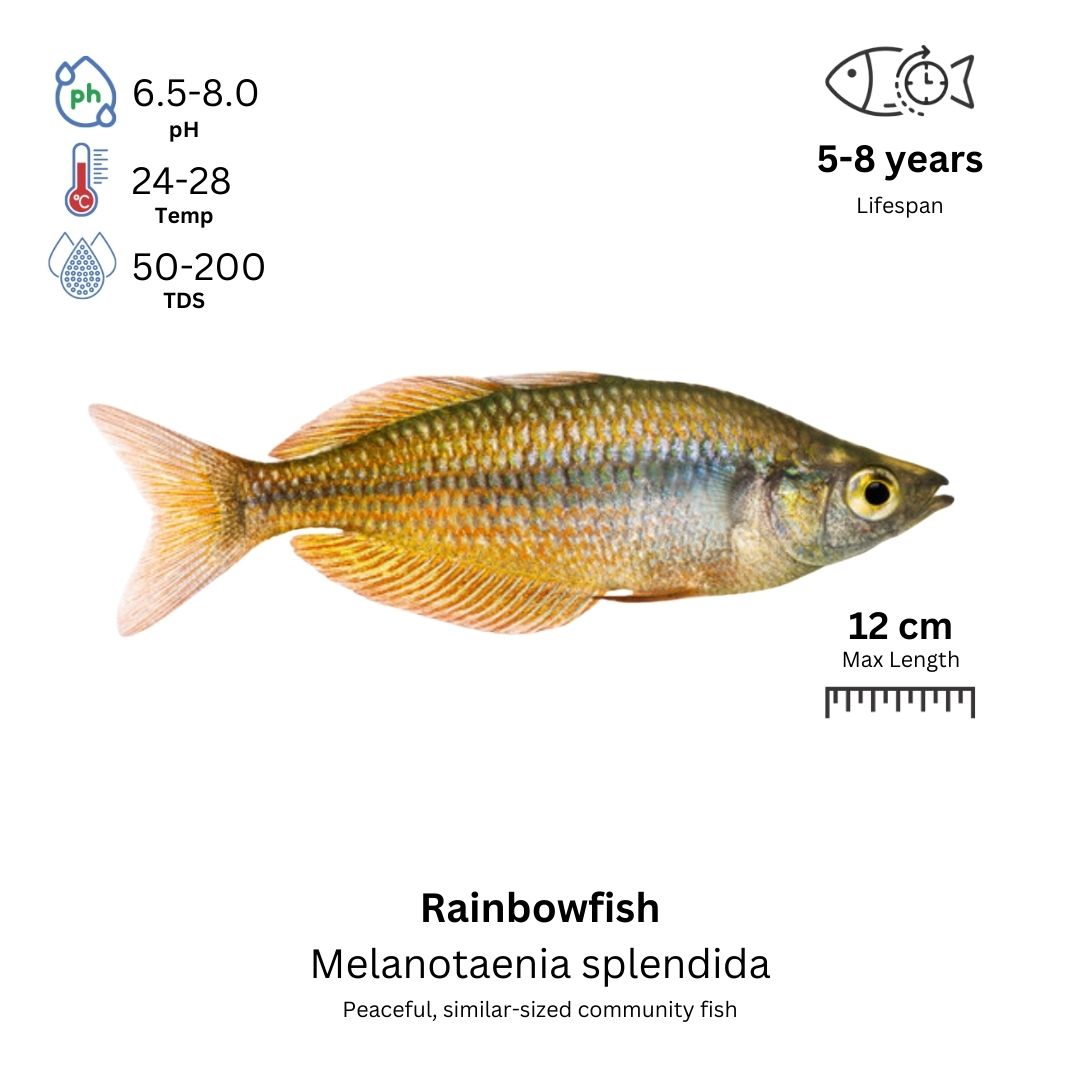Rainbowfish: A Colorful and Energetic Addition to Your Aquarium
Introduction
Rainbowfish are vibrant, active, and peaceful freshwater fish, known for their iridescent colors that shift depending on lighting and viewing angles. Belonging to the Melanotaeniidae family, these fish are native to Australia, New Guinea, and parts of Southeast Asia. With their hardy nature, schooling behavior, and dazzling colors, Rainbowfish are an excellent choice for community tanks.
Characteristics
- Scientific Name: Various species (e.g., Melanotaenia boesemani, Melanotaenia praecox, Glossolepis incisus)
- Common Name: Rainbowfish
- Family: Melanotaeniidae
- Size: 2–6 inches (5–15 cm), depending on species
- Lifespan: 5–8 years
- Behavior: Peaceful, schooling fish
- Care Level: Easy to moderate
Origin and Distribution
Rainbowfish are primarily found in Australia, New Guinea, and Indonesia, thriving in freshwater rivers, lakes, and streams with warm, clear water. Their natural habitat includes densely planted waters with slow-moving currents, where they feed on small insects, crustaceans, and algae.
Some of the most popular species include:
- Boesemani Rainbowfish (Melanotaenia boesemani) – Famous for its blue-to-yellow gradient.
- Dwarf Neon Rainbowfish (Melanotaenia praecox) – A small species with a bright blue sheen.
- Red Irian Rainbowfish (Glossolepis incisus) – Deep red body with metallic highlights.
- Turquoise Rainbowfish (Melanotaenia lacustris) – Striking blue-green coloration.
Colors and Markings
Rainbowfish are named for their shimmering, multi-colored scales that change depending on light and movement.
- Males develop deeper, more intense colors, especially during breeding.
- Females are slightly smaller and have duller coloration.
- Most species exhibit horizontal stripes, metallic sheens, and bright-colored fins.
💡 Tip: Providing high-quality food and proper lighting enhances their vibrant colors!
Tankmates
Rainbowfish are peaceful, active schooling fish, best kept in groups of at least 6 individuals to reduce stress and promote natural behaviors.
✅ Compatible Tankmates:
- Other Rainbowfish (Boesemani, Turquoise, Neon, etc.)
- Tetras (Rummy Nose, Cardinal, Black Neon)
- Rasboras (Harlequin, Scissortail, Chili)
- Corydoras Catfish
- Gouramis (Honey, Pearl)
- Livebearers (Mollies, Platies, Swordtails)
- Snails and Shrimp (Amano, Nerite, Bamboo Shrimp)
🚫 Avoid:
- Aggressive or territorial fish (Cichlids, large Barbs).
- Slow-moving fish (such as Bettas) that may struggle with Rainbowfish’s fast pace.
Care Requirements
To maintain healthy and colorful Rainbowfish, provide a spacious and well-maintained aquarium.
Tank Setup:
- Tank Size: Minimum 30 gallons for small species, 55+ gallons for larger species.
- Water Temperature: 22–28°C (72–82°F).
- pH Level: 6.5–7.5 (neutral to slightly alkaline).
- Water Hardness: 8–15 dGH (moderate hardness).
- Filtration: Moderate to strong flow, replicating their natural habitat.
- Aquarium Setup:
✔ Live plants (Java Fern, Anubias, Vallisneria) for cover.
✔ Open swimming space for their energetic nature.
✔ Substrate: Dark-colored gravel or sand enhances their coloration.
🚨 Tip: Regular weekly water changes (25–30%) help maintain water quality and prevent stress.
Diet and Feeding
Rainbowfish are omnivores, requiring a balanced diet for optimal health and coloration.
Best Foods:
✔ High-quality flakes or pellets (protein-rich formulas).
✔ Live or frozen foods (brine shrimp, daphnia, bloodworms).
✔ Vegetable-based foods (spirulina flakes, blanched zucchini).
Feed small portions 2–3 times daily to prevent overfeeding and maintain good water quality.
💡 Tip: A diet rich in carotenoids (found in shrimp and spirulina-based foods) enhances their red, orange, and yellow hues.
Gender Differences
- Males are more colorful, with larger dorsal and anal fins.
- Females are slightly smaller with a more subdued color palette.
- During breeding, males intensify their colors to attract females.
Breeding Rainbowfish
Rainbowfish are egg scatterers, meaning they lay non-adhesive eggs among plants.
Breeding Process:
- Condition the breeding pair with high-protein foods.
- Set up a separate breeding tank with fine-leaved plants or a spawning mop.
- Males perform courtship displays, showcasing their best colors.
- Females lay eggs daily, which hatch in 7–14 days.
- Feed fry infusoria, baby brine shrimp, or powdered fry food.
🚸 Tip: Remove adults after spawning to prevent them from eating the eggs.
Common Health Issues & Solutions
🔴 Ich (White Spot Disease):
✔ Solution: Increase temperature to 28°C (82°F) and use anti-parasitic treatments.
🔴 Fin Rot or Fungal Infections:
✔ Solution: Maintain clean water conditions and use mild antifungal medications if needed.
🔴 Bloating or Swim Bladder Issues:
✔ Solution: Feed fiber-rich foods like blanched peas to aid digestion.
🚨 Tip: Quarantining new fish before introducing them into your tank helps prevent disease outbreaks.
Additional Resources
For more Rainbowfish care tips, check out:
- Best Tankmates for Rainbowfish
- How to Enhance Rainbowfish Colors Naturally
- Breeding Rainbowfish: A Complete Guide
Conclusion
Rainbowfish are stunning, active, and hardy freshwater fish, perfect for large community aquariums. Their vibrant colors, fast swimming style, and peaceful nature make them a top choice for aquarists of all levels. With proper care, a nutritious diet, and a well-maintained environment, Rainbowfish will thrive and become a dazzling centerpiece in any aquarium.


Reviews
There are no reviews yet.